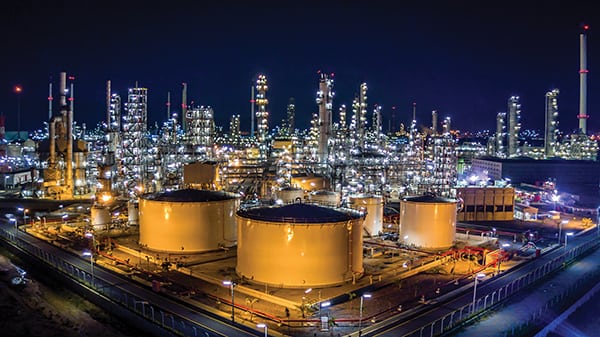Responsiveness and adaptability — in the face of shifting market forces, new regulatory policy and natural disasters, among others — framed the discussions of U.S. petroleum refiners at the AFPM annual meeting
Responsiveness and adaptability for U.S. petroleum refiners emerged as a theme at the most recent annual meeting of the American Fuel and Petrochemical Manufacturers (AFPM; Washington, D.C.; www.afpm.org) in New Orleans, with those concepts framing many of the discussions and presentations at the meeting. While the overall mood of refiners and petrochemical producers is generally very positive, there are a number of developments that require industry players to respond and adapt, both to take advantage of new opportunities and also to avoid potential problems.
For example, the effects of increased crude petroleum production from U.S. shale deposits, coupled with the effects of the higher crude exports over the past two years, are still resounding throughout the refining and petrochemical sectors, forcing refiners to strategize based on a new set of rules for the crude oil landscape. In addition, refiners are looking for ways to respond to impending restrictions in the amount of sulfur permitted in marine fuels. Further, the refining industry must formulate strategies for responding to differentials in demand growth for transportation fuels compared to chemical precursor products.
Another manifestation of the “responsiveness and adaptability” theme was in discussions at the AFPM meeting of plant-level responses to natural disasters — petroleum refinery and petrochemical facility executives shared stories of resilience from Hurricane Harvey’s aftermath (see section on hurricane response below). This article describes several of the major issues that are pushing companies and facilities to adapt and respond, and what the wider implications may be for the industry.
Ripple effects from shale and exports
Along with dramatic increases in oil and natural gas production from the “shale boom” in the U.S., the lifting of export restrictions on crude oil for U.S. refiners in December 2015 led to seismic shifts in crude-oil markets and petrochemical production across the globe. These shifts continue to shape petroleum refining conditions in 2018 as their effects ripple outward. Although the news is generally good for U.S. refineries, these ripple effects are requiring that refiners respond to a much different global reality than was the case a few years before.
“The effects of the decision to allow U.S. crude oil exports are still echoing in 2018, and still working themselves out,” comments Mark Routt, chief economist for the Americas at KBC Advanced Technologies Inc. (KBC; Houston, Tex.; www.kbcat.com). According to AFPM’s 2018 annual report, the U.S. currently now exports nearly 80 billion barrels (bbl) of crude petroleum per month, most of it light, sweet crude from shale deposits in West Texas and New Mexico destined for Europe, Latin America and Asia. Since the crude export restrictions were lifted in 2015, the increased exports have allowed the glut of oil “trapped” in the U.S. to “drain” out of the country. Many forecasts, such as one from the International Energy Agency (IEA; Paris, France; www.iea.org), predict that U.S. crude oil exports will become a net oil exporter within the next several years (and a net natural gas exporter sooner than that).
In general, the increased petroleum production and freed crude exports have favored U.S. refineries and petrochemical manufacturers. AFPM president Chet Thompson pointed out that refinery utilization in the U.S. is at 90%, and petrochemical exports from the U.S. are up 60% in two years.
However, the fortunes of individual refiners depend on their ability to adapt quickly to dynamic market conditions and government policies. “Refiners need to be nimble,” says Mark Routt, of KBC, because “the situation is constantly changing and often rapidly.”
Crude oil transportation infrastructure, including pipelines, shipping terminals, docks and others, plays a key role in refinery strategies and decisions. For example, numerous announced pipeline and terminal projects in Corpus Christi, Tex. could allow significantly more crude oil from the Eagle Ford and Permian shale plays to be stored and shipped from there.

Figure 1. Restrictions on sulfur content for marine fuels will likely widen price differentials between sweet and sour crude oils and between light and heavy crudes
Low-sulfur marine fuels
Among the prominent topics at AFPM was the petroleum refining industry’s response to regulatory policy that restricts the levels of sulfur in marine fuel (Figure 1; also known as bunker fuel; a heavier, higher-boiling-point fraction of crude oil than gasoline and diesel fuel that is burned for power). In late 2016, the International Maritime Organization (IMO; London, U.K.; www.imo.org), an agency of the United Nations, decided to implement a tighter schedule for restricting sulfur from stacks on ships. The ruling requires that ships use bunker fuel that contains 0.5% sulfur residue by 2020, rather than by 2025. The current sulfur cap on bunker fuel is 3.5% residual sulfur.
The impending cap on sulfur content has implications for refineries because bunker fuels will be based on petroleum distillates, rather than fuel-oil fractions. “While the future for the refinery sector looks good globally, the IMO restrictions represent a big question mark,” because of uncertainties over how to find uses for the displaced high-sulfur fuel oil, explains John Mayes, a consultant at the firm Turner & Mason (Dallas, Tex.; www.turnermason.com). Other questions are also raised, such as whether refiners will add desulfurization capacity, and to what extent exhaust gas scrubbers will be installed on large ships to allow them to burn high-sulfur fuel oil and remain in compliance. There is also some uncertainty surrounding the details of how the regulation will be enforced.
To date, very little progress has been made by the refining sector, in terms of new construction, to deal with the sulfur limits brought about by the IMO decision, Mayes says. And any projects started now to increase capacity to process high-sulfur feedstocks into compliant fuels likely will not be completed by the 2020 date when the restrictions go into effect.
According to an analysis by KBC, the IMO cap on sulfur content in marine fuel will “widen the price differentials between light and heavy crudes and between sweet and sour crudes.” Further, “prices of sweet crudes will go up, while sour crude prices will go down,” says Mel Larson, principal consultant at KBC. “High-sulfur fuels will eventually be phased out entirely and low-sulfur fuel will be the only viable option.”
The shift to low-sulfur marine fuel will also require upgrading investment by refineries to cut high-sulfur fuel oil (HFSO) production and upgrade product yields. The end result is a high probability that more than 2 million bbl/d of HFSO will be stranded in the market because of this decision,” KBC’s Routt says. KBC projects that HFSO prices will drop to close to coal prices. “The effect on refinery margins depends on the percentage of exposure in the HSFO market,” the analysis states. Opportunities for refineries to optimize their crude diets and increase coker utilization may arise from these developments. On the other hand, low-complexity refineries are exposed to a number of risks.
There will be a large need to find a home for bottoms fractions, because it will be more difficult to use them in the pool of marine fuel oil fuels, Larson says. U.S. refiners need the ability to process bottoms with high-sulfur content.
“The most obvious refinery response [to the surplus of HFSO] would be coking,” Turner & Mason’s Mayes explains, because coking can crack some of the long chains into more marketable fuels. “Refineries that have coking operations will do well, but there will still be too much fuel oil to use in the available cokers, so it will need to find other uses,” he comments. Mayes also comments that large volumes of low-sulfur distillates and gas oil will be blended into the bunker fuel pool to reduce overall sulfur content, which will lead to a spike in demand for these distillates.
Ships can install onboard scrubbers, but they are costly and there is uncertainty in the marine shipping sector about whether or not scrubbers are worth the investment. The alternative is to burn low-sulfur fuel oil on ships, so the demand for sweet (low-sulfur) crude oils will rise.

Figure 2. Projected fuel-efficiency gains for advanced internal combustion engines and a greater number of electric vehicles on the road could flatten demand growth for gasoline in the longer term
Fuel quality and octane
In addition to responding to changes on the marine fuels, U.S. and international petroleum refiners are also addressing changes in fuels for land vehicles, including several parallel trends that could reduce future demand for gasoline.
Among these trends are a rising number of electric-powered vehicles, improved higher-efficiency internal combustion engines, and more “mobility-as-a-service” businesses (including car-sharing and others; Figure 2). At the AFPM meeting, General Motors (New York, N.Y.; www.gm.com) vice president for global propulsion systems Dan Nicholson outlined these trends, all of which have the effect of modulating demand growth for gasoline and diesel fuel.
He stressed that internal combustion engines will not disappear any time soon, but that going forward, vehicle engines will pursue efficiency gains and will require gasoline with higher octane numbers. Nicholson pointed out that 95 RON (research octane number) may be optimal for many of the future engines. Today’s premium gasoline is typically 93 RON and regular gasoline is 87.
Because of these changes, refiners must find ways to maximize octane numbers and boost yields of premium gasoline in their product slate, even as they keep a close watch on gasoline and diesel demand. Alan Gelder, senior analyst for Wood Mackenzie (London, U.K.; www.woodmac.com) says that, along with the IMO decision, maximizing octane is the biggest issue for refiners right now.
“[Corporate average fuel economy (CAFE)] standards on vehicle efficiency are driving up the demand for higher-octane fuels,” he says. “Everyone is going to want premium gas.” He adds that if gasoline demand declines, refiners must think through their options.
A few announcements at the AFPM meeting may have relevance to questions of rising octane needs. One solution, presented by New Gas Technologies (NGT; Houston, Tex.; www.ngts.us), is the first commercial methaformer, which combines methanol with naphtha to yield sulfur-free, high-octane gasoline at much lower costs than catalytic reforming and isomerization, the conventional route. To read more about this technology, see the Chementator section of the May issue of CE).
Another related development for diesel fuel quality involves a new hydrotreating catalyst from Honeywell UOP (Des Plaines, Ill.; www.uop.com) designed to allow refiners to convert lower-value diesel blending components into fuels that meet more stringent fuel-quality specifications. For more information on this new catalyst, see the Chementator section of the May issue of CE.

Figure 3. To take advantage of growth in petrochemical markets, refiners are exploring configurations to allow direct production of petrochemical products and petrochemical feedstocks from crude oil
Oil-to-chemicals strategies
Because of planned improvements in engine efficiency for new vehicle fleets and the growth of alternative vehicle propulsion technologies, demand growth for common transport fuels is not expected to be strong over the longer term, many industry watchers say. In contrast, demand for petrochemical products is projected to see much greater demand growth, driven by global population increases, improving living standards and demographic shifts from rural to urban areas.
In response to this market scenario, petroleum refiners are thinking more broadly and strategically about converting crude oil into consumable products, rather than fuels (Figure 3). This includes compounds such as olefins, polyols and aromatics, that have not generally been a focus of refiners’ normal product range. “This imbalance has made the idea of using crude as a direct feedstock more appealing,” says Clyde Payn, CEO of The Catalyst Group (Spring House, Pa.; www.catalystgrp.com).
“In the past, the mindsets of refiners and petrochemicals were completely separate — while the former was geared toward commodity products, the latter was focused on specialty product markets,” explains KBC’s Mark Routt. As time went on, refinery-petrochemical integration (RPI) became a tool to improve refinery margins. But a “third phase of RPI is just beginning now,” Routt says, in which engineers are “designing refining and petrochemical capacity in an integrated way from the beginning, to give manufacturers as much optionality as possible.”
While RPI is not a new concept, the novelty is in “orienting the refinery portion of a complex specifically to produce petrochemicals or feedstocks for petrochemicals,” explains Jerry Price, senior consultant at Jacobs Engineering Group (Dallas, Tex.; www.jacobs.com). “One is able to utilize the chemistry of proven refining and petrochemical technologies to maximize the value from each stream in the facility.”
At the AFPM meeting, Price discussed the possibilities of oil-to-chemicals (OTC) strategies, as well as his company’s offering, known as Jacobs C2C (crude to consumables), which focuses on “getting the right molecules into the right process units to maximize value,” he says. Among the petrochemicals figuring prominently in these strategies are olefins (ethylene and propylene), aromatics (benzene, toluene and xylenes) and special intermediate streams like C4 compounds and higher olefins.
One example of an OTC concept that Jacobs has explored significantly is high-propylene-yielding configurations utilizing steam cracking in conjunction with a residue fluid catalytic cracking (RFCC) unit. “In certain instances, these configurations could yield up to 12–15 wt.% propylene on crude for the overall complex,” Price says.
Speaking more generally, KBC’s Mark Routt cites another example of how to create refinery-petrochemical integration with heat-exchange and steam systems. “Refinery operations tend to require a great deal of heat, so they have elaborate heat-exchange systems, as well asdifferent steam pressures and so forth,” Routt says. “Petrochemical manufacturing needs more rotating (motive) energy, which creates opportunities for integration between the two,” he says. For example, “you could take steam and pass it through a gas-condensing turbine and turn that steam, which is thermal power that a refinery uses, into motive energy for use in petrochemical production processes.”
Within the context of OTC, “lighter crudes containing higher levels of naphtha have an inherent advantage over heavier crudes, because they can achieve significant conversion to petrochemicals while reducing the capital investment required to convert the vacuum gas oil (VGO) and residue portions of the crude into naphtha or naphtha-like streams,” Price says.
RPI investment decisions
Oil-to-chemicals can be a complicated undertaking, because many needs should be considered. This includes not only choosing “the appropriate configuration to make the right products,” but also “building in an optimal location, licensing the most suitable technologies, finding investors to finance the project, and selecting an experienced contractor to construct it,” Price remarks.
Making investments in OTC strategies requires companies to look closely at their inherent competitive advantages. “Do they have access to cheap crudes or other feedstocks that could be utilized in a new refinery-petrochemical-integrated facility? Do they have a captive market or industry that can utilize the products? How are they positioned with respect to competition in the fuels or petrochemical market? These are the types of questions one should consider before pursuing an OTC investment,” Price says.
“While a grassroots opportunity allows one to start with a blank sheet and explore all possibilities, revamping an existing fuels-oriented refinery is certainly possible,” Price says. The latter is a more complex proposition, requiring a higher level of knowledge of both the refining and petrochemical processes, he explains. Because of this, Jacobs has cultivated expertise in developing novel configurations, and remains technology-neutral to avoid being tied to a particular portfolio of process technologies.
An example of a grassroots effort is the development of the world’s largest fully integrated OTC complex in Saudi Arabia. Late last year, Saudi Aramco and SABIC signed a deal to build a $20-billion OTC complex. The complex is expected to process 400,000 bbl/d of crude oil and produce approximately 9 million ton/yr of chemicals and base oils.
In evaluating OTC strategies, refiners must weigh the additional capital and operating expenses against the potential improvements in internal rate of return, along with the company’s appetite for business risk and ability to raise funding, Price says.
RESPONSE TO HURRICANE HARVEY 2017
In keeping with the refinery response theme, AFPM attendees took a look back to August 2017, when Hurricane Harvey caused flooding on a massive scale along the Gulf Coast and in Houston. It was pointed out at the meeting that Hurricane Harvey impacted 60% of U.S. petrochemical production and 25% of refining capacity, according to AFPM, in addition to ports, terminals, rail stations, pipelines and other infrastructure. However, the recovery was rapid, with 20 of 24 refineries shut down because of the storm restarted within two weeks of Harvey’s landfall. And 70% of petrochemical production impacted by the storm was resumed within of three weeks of the Hurricane, according to AFPM.
In a special panel session, several executives from plants near Houston that were affected by Hurricane Harvey talked about how the storm affected their facilities and employees and how their response was mounted. The following are points made by panelists at the session.
- These industry sectors to strive to “harden” their facilities against natural disasters.
- Setting up emergency command and communication centers is a good strategy for getting through the event
- Mobility challenges (flooded roads, and so on) are likely during a natural disaster, and can have a large effect on employees’ ability to get themselves to the plant
- Taking care of affected employees is important. Reserving hotel rooms before a storm, making grants and no-interest loans to employees can be big helps for those that are heavily affected
- It is helpful to work with local police and fire forces on monitoring and security needs for the facility during and immediately after the storm
- Hurdles to coming back include restoring infrastructure outside the plant (docks, pipelines, railroad bridges, and so on); replacing equipment, replacing instruments, ensuring supplies of hydrogen, nitrogen and others required materials; remediating mold, and others
- The lesson is “you can’t be overprepared”
- Drone technology can be helpful in emergency response
- Communication with federal government was better than previous with this storm